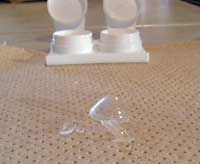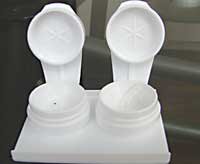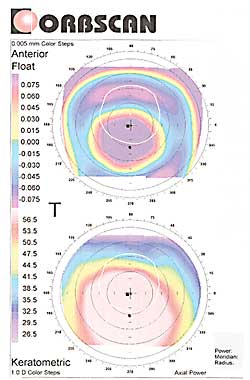GP lenses may protect against trauma, toxic chemicals
Contact Lenses and Eyewear
Do contact lenses protect the eye? Some case reports and studies indicate that gas-permeable lenses and hydrogel lenses actually decrease the wearer’s exposure to toxic irritants in the environment and may decrease damage from mechanical trauma.
This is a case report where a contact lens protected the eye from acute trauma. CM was a 20-year-old man with severe keratoconus. He had apical thinning that measured less than 300 microns at the corneal apex, per the Orbscan (Bausch & Lomb, Rochester, N.Y.). Central corneal thickness was less than 450 microns in each eye. His corneal curvature measured greater than 60 D in the right eye and 52 D in the left eye.
When I first met CM, his uncorrected vision was OD 20/70 and OS 20/50. His visual acuity did not improve with manifest refraction, so glasses were not an option.
The patient came to me in hopes of improving his vision but admitted he had tried contact lenses in the past without success. We tried many large- and small-diameter corneal lenses. We tried several soft keratoconus lenses. The patient found that all of these lenses were uncomfortable, and while his vision improved, it was still never better than 20/40-.
Scleral lens well tolerated
His parents then talked to me about the possibility of sending him to Boston for a fitting with the Boston Scleral Lens. I wrote a letter to Dr. Perry Rosenthal’s Boston Foundation for Sight, Chestnut Hill, Mass., including CM’s topography and recent exam findings. The foundation accepted CM into the program, and he went to Boston for the fitting.
CM returned to me several months later for a contact lens follow-up. He tolerated the scleral lenses he was wearing for all his waking hours, and his vision was OD 20/25 and OS 20/25. He was a happy patient. I lost track of CM for a few years after that.
The Boston Scleral Lens
The Boston Scleral Lens is a large-diameter lens (15.0 mm to 23.0 mm) made from a fluorosilicone/acrylate polymer (Equalens II Polymer Technology, Bausch & Lomb). The lens bears completely on the sclera and vaults the cornea. It has a permeability value of 127 x 10-11 cm2 mL O2/sec mL mm Hg. The center thickness ranges from 0.25 to 0.39 mm. The Food and Drug Administration approved it in 1994.
Indications for scleral contact lenses are many, but their primary role continues to be managing corneal abnormalities, especially primary corneal ectasia, corneal transplant and ocular surface disease.
Patient sustained blunt force trauma
Last fall, I received an urgent call from CM, saying that a rock hit him in the right eye while he was mowing the lawn. He was in severe pain. Upon examination, visual acuity in his right eye was 20/400. He was barely able to open his eye until I instilled a drop of local anesthetic. Slit lamp exam revealed multiple pieces of a Boston Scleral Lens under the upper lid, lower lid and scattered throughout the cornea. With a forceps, saline flush and patience, I removed all of the pieces.
Once I removed the material from CM’s eye, I performed a careful slit lamp examination. I found no penetrating injury, and although there was mild corneal and conjunctival staining, the abrasions were small and shallow. There was no sign of infection. The conjunctiva showed mild injection, the anterior chamber was quiet, and the IOP was normal. Lids, lashes and ocular adnexa were uninvolved. The eye’s involvement was superficial.
I started CM on a topical broad-spectrum antibiotic four times a day for prophylaxis against infection. I also started him on an aggressive regimen of artificial tears, every hour while awake, to lubricate, hydrate and flush the eye surface.
Considering the blunt force with which the rock hit his eye — which was strong enough to break the contact lens — this contact lens probably saved CM’s right eye from much more severe damage.
|
|
Images: Brown MJ |
Studies: Lenses minimized damage
Cavanagh examined 128 occupational eye injuries in individuals who were wearing contact lenses at the time of injury. The researchers looked at various injuries, including physical trauma. This study confirmed and extended previous findings that, overall, contact lenses partially protected and minimized injuries. It showed that some types of contact lenses provide important protection by decreasing the exposure of the eyes to volatile or toxic solvents in the air. The researchers concluded that contact lenses minimized rather than worsened some injuries.
Bandage contact lenses are widely used to protect the cornea after injury such as corneal abrasion, mechanical manipulation such as surface surgery and a painful episode with bullous keratopathy or recurrent corneal erosion. Bandage contact lenses are also used to treat pain in cases of post-PRK, penetrating keratoplasty and LASEK. When covered with a topical broad-spectrum antibiotic and sometimes a topical nonsteroidal anti-inflammatory, this is an accepted way to treat ocular surface insult and pain.
Special lenses are used to protect the eye on a temporary basis while the cornea is healing. Lens use is also well accepted in patients with highly irregular corneas such as multi-incision radial keratotomy or ectatic corneas. These lenses allow patients to function visually where they may not be able to with conventional means.
Hejkal and colleagues found that eyes fit with GP contact lenses experienced less corneal damage and increased protection against strong acids. In the study, researchers simulated chemical splash accidents with acetic acid, n-butylamine or acetone in laboratory animals.
A similar study found that high-water content hydrophilic contact lenses increased the concentration of the vapors of trichloroethylene and xylene. However, although the vapor uptake by the contact lenses was considerable, the solvents were released primarily back into the air, not into the eye. In other words, wearing high-water content hydrophilic contact lenses did not expose the cornea to more potential damage from chemicals.
Protection against mechanical trauma?
|
Images: Roth JM |
In an attempt to determine if contact lenses protect against mechanical trauma, a study by Nilsson and colleagues in the early 1980s fit anesthetized rabbits with contact lenses and then exposed them to showers of burning grit particles. GP contact lenses provided efficient protection for the covered part of the cornea. Soft lenses also had a certain protective effect because the majority of the particles rebounded and the others caused only superficial epithelial damage to the cornea. The soft lenses themselves sustained heavy damage.
More recently, Tang and colleagues at the University of California Los Angeles reported two cases of GP lens wearers who were protected from serious foreign body-related injury through contact lens wear. The conclusion was that although contact lenses are not recommended for protective purposes, GP lenses could protect against some types of trauma.
In 1997, Owen and colleagues used questionnaires to determine if firefighters could be safe wearing contact lenses. Twenty-nine firefighters were fit with soft contact lenses and 21 with GP lenses. All contact lenses wearers reported a statistically significant decreased reduction in how often they experienced irritable foreign bodies and irritant fumes in the eyes compared to non-contact lens wearers. In addition, firefighters felt that contact lens use improved their performance on the fire ground.
While these benefits are apparent, we cannot sanction their use as a primary form of protection. These cases may have significant relevance in industry, laboratory and other workplace situations. While contact lenses themselves cannot be used as primary protection, restricting contact lenses may be unnecessary.
As eye care providers, we must remember that the findings mentioned here do not apply to all chemicals, solvents and mechanical trauma, so great care and knowledge of various chemicals and their effects are still necessary.
People must take additional safety precautions when working around concentrated chemicals that can cause severe ocular irritation or surface damage to the cornea. People who participate in activities where they are at risk of exposure to severely toxic chemicals and vapors, such as concentrated acids or lye, and to flying objects such as grinding, chopping or lawn mowing should always wear a pair of well-made safety goggles.
For more information:
- Marlane J. Brown, OD, FAAO, is a contact lens specialist and provides surgical comanagement at Minnesota Eye Consultants. She is also on staff in the Ophthalmology Department at the Regions Hospital Eye Clinic and is a former president of the Minnesota Optometric Association. She can be reached at Minnesota Eye Consultants, 710 East 24th Street #106, Minneapolis, MN 55404; (612) 813-3621; fax: (612) 813-3636; e-mail: mjbrown@mneye.com.
References:
- Cavanagh HD. Contact lenses in the industrial workplace: Are they safe? CLAO J. 1992;18:11.
- Hejkal T W, Records RE, Kubitschek C, Humphrey C. Diffusion of volatile organics through contact lenses. CLAO J.1992;18:41-45.
- Nilsson SE, Lovsund, P, Oberg, PA. Contact lenses and mechanical trauma to the eye. An experimental study. Acta Ophthalmol (Copenh). 1981;59:402-408.
- Nillssen, SE. Anderson, L. The use of contact lenses in environments with organic solvents, acids, or alkalais. J. Occup Med. 1975. March 17 (3): 163-6.
- Tang, K., Shah, A., McMahon, TT., Weissman, B. Gas Permeable contact lenses can protect against ocular trauma: Two cases. Eye Contact Lens. September 2005;3:244-5.
- Owen, CG., Margrain, TH., Woodward, EG. Use of contact lenses by firefighters. Part 1: Questionnaire data. Ophthalmic Physiol Opt. March 1997;17:102-11



